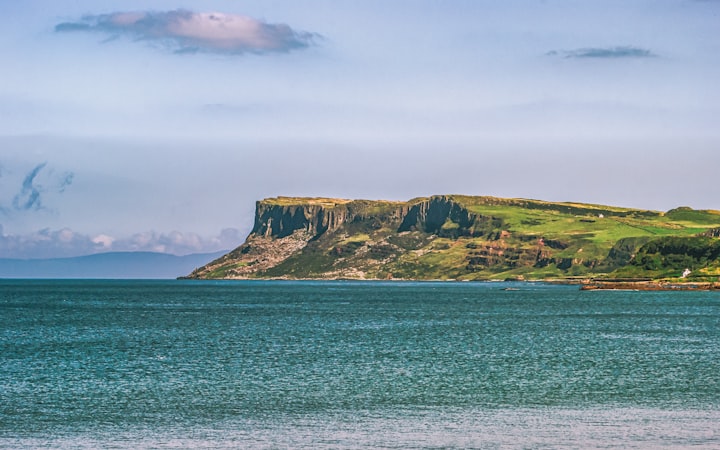Aran & Shetland Knitwear: Brief History
The top two travel destinations I'm dying to go with a fuzzy history of fashion.

Almost everyone from the United Kingdom and Ireland has dabbed in the wool trade since the beginning of time. The conditions were rough, with cold and bitter winters to mild summers. Wool was the top export of all Isle inhabitants. But just north of Edinburgh and off the Northern coast of Ireland are two islands whose main exports well into the twentieth century came with the wonders of their limited economy.
Scotland's Shetland Isles and Ireland's Aran Isles are two of the places I am dying to travel to when COVID is over. It is not because of those adorable puffin pictures you can find on the internet when you Google these far-off places. These beautiful places are cold and bitter, but they have a connection to my favorite hobby, knitting. Aran and Shetland knitwear are durable and reliable. In early cases of having to identify bodies lost at sea or land, easy to identify which farmer or sailor lost their life by the pattern their wives would make into the sweaters or accessories they would wear out in the stinging winds of the near-Arctic conditions.

Aran Knitwear often comes in several cabling patterns: Basic cable, diamond, zig-zag (also known as marriage lines), honeycomb, trellis, or tree of life. Each knitwear has a distinct meaning. Shetland Knitwear is versatile to use in sweaters, in which the same patterns are used all over the Nordic countries, but also in wedding attire. Some of the famous knitting patterns from the Shetland Isles are lace-weight patterns known as fern, horseshoe, fishtail, or cat's paw. Shetland Lace can be thin enough to go through a wedding ring. It was a popular gift item favorite by the infamous Queen Victoria, who loved all things Scottish. She even demolished the original Balmoral Castle to move it further towards the creek behind the original house.
The wool from Shetland sheep comes from a possible Viking introduction, which we know as North Atlantic Short-Tailed Sheep. They have a double coat an inner coat can make the 1-ply yarn which is finger weight for wedding attire, baby items, etc. The outer makes 2-ply yarn used in outdoor wear such as scarves, sweaters, chunky knits, etc. The oldest known ply yarn is called a hap. The hap was used by Shetland women when working outside on a croft or private tenant farm. This plied yarn is no longer available. The lace knitting from the Shetlands became part of the long industry of lace making that helped with the local economy around the 1840s. Many Victorians at the time could order or purchase Shetland lace shawls from this northern region and use them for special ceremonies or as indoor luxury items to wear around the house.

The Aran Islands are a bit different. The Aran knitwear we commonly see going in and out of fashion didn't become popular until the 1950s. They were fishermen's sweaters because fishermen's wives would make these sweaters by hand while the men worked out in the cold, bitter sea. Back in the day, a hand-knit Aran sweater took anywhere from three to six weeks to finish.
Guernsey, an island 400 miles south-east, was the origin of the famous Aran knit sweaters. The economy relied heavily on fishing. The clothing had to work with the extreme demands of everyday labor to keep up with the harsh conditions.
Around 1935, the Aran sweater made its way to the Dublin Market on the mainland of Ireland. As the knitwear evolved, the yarn became much thicker, and the sweaters were knitted flat. The stitching became much looser as the intricate patterns continued to develop. These changes made it much easier to knit an Aran sweater in less time and caused a production boom from the Aran Islands and Guernsey.
Around the same time production of Aran sweaters was taking off, a group of Scottish fishermen and lady folk arrived on the island to help with tips and tricks for making sweaters to earn a living and effective fishing techniques out in the freezing waters of the Northern Atlantic.
I hope to travel to these paradises for knitters; if I am still knitting around that time. Right now, I have my yarn horde to work in and knit through to the very end. I still dream of going to these majestic islands with their fuzzy history in knitwear and fashion. At least we can say thank you to Queen Victoria once in a while.
Works Cited:
https://www.vam.ac.uk/articles/british-knitting-traditions
https://fairlightfibers.com/blogs/news/great-ideas-shetland-wool-pattern-ideas
https://icelandicknitter.com/27-things-from-shetland/
https://jamiesonandsmith.wordpress.com/category/knitting-patterns/
https://magdamakes.com/shetland-knitting/
https://www.shetlandlaceshawls.co.uk/history
https://www.knitting-naturally.com/shetland-lace-knitting.html
https://www.sweatershop.com/blog/history-of-aran-sweaters
About the Creator
Heather Wilkins
Born in South Carolina, raised in Florida. I enjoy writing for therapy or stress release. Enjoy my ramblings or any updates on cities where I live.






Comments
There are no comments for this story
Be the first to respond and start the conversation.